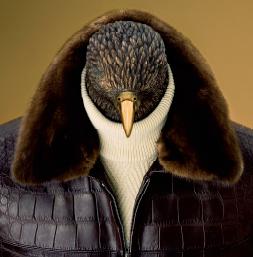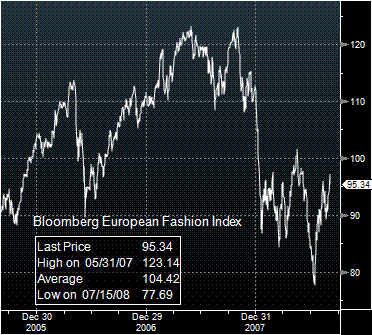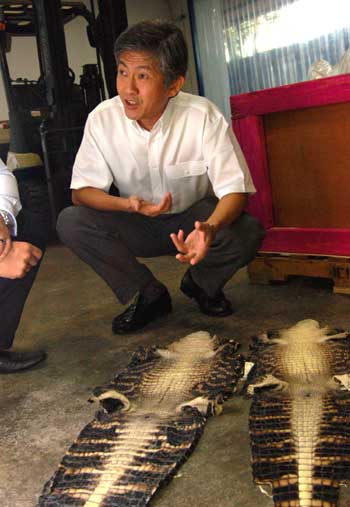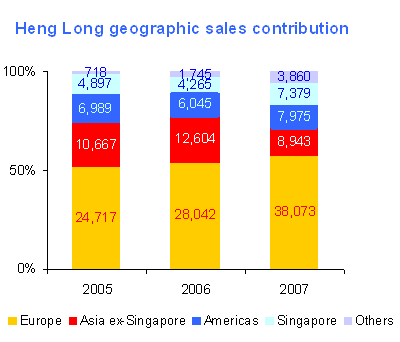
“CROCODILE SKIN is the most precious type of leather to makers of luxury goods,” said Koh Choon Heong, an executive director of Heng Long International, which was listed in July on the mainboard of the Singapore Exchange (IPO price: 34 cents).
Manufacturers for numerous luxury brands like Prada, A. Testoni, Rolex and Franck Muller use Heng Long’s crocodilian leather for their jackets, handbags, wallets, belts, boots, shoes, watches, and the like.
Handcrafted by master artisans, these luxury goods adorn royalty, movie stars and celebrities, and are also promoted on the big screen in blockbuster movies such as Sex and the City and The Devil wears Prada.
A single piece of top grade crocodile skin can cost the garment manufacturer S$1,000 or more, and one crocodile jacket requires about six such pieces.
Thus, a piece of Hermès crocodile leather jacket retails for S$60,000 to S$100,000. Limited editions and a special product line may be sold for twice that amount.
There are only 5 tanneries in the world today specializing in high-end crocodilian leather for luxury goods makers.
Not only is Heng Long one of them, it is also one of only two such tanneries yet to be taken over by a luxury goods giant.
French luxury goods giant Hermès already owns two of these (Gordon-Choisy and Tanneries des Cuirs d'Indochine et de Madagascar).
The world’s second largest fashion house, Gucci, also owns one (Caravel SpA Pelli Pregiate).
European Fashion Index bucks global down trend
The global economy is slowing down, from North America, to Europe, Asia and all the way to Australia.

Despite this, the Bloomberg European Fashion Index (BBEF Index), comprising of 13 stocks in Europe’s luxury goods industry --- such as Burberry, Christian Dior, LVMH Moet Hennesy Louis Vuitton and Hermès --- has rebounded sharply in the past couple of months.
BBEF Index is now up about 30% from its 5-year low in July 2008.If the index reads impending demand for luxury goods correctly, then strong demand is in store for Heng Long, as more than half of its revenues come from the European luxury goods market.
The business is a stable one, with cumulative average sales growth of 17% over the past two years. Heng Long's net earnings were S$11 million in FY07, on revenues of S$66 million.
Gross margins have been expanding, from 27% in FY05 to 31.6% in FY07. FY07 net margins were 16.8%.
”Demand for luxury raw materials has always been pent up due to its scarcity,” said Mr Koh, when explaining his company’s ability to increase prices.
Like luxury goods makers, the large crocodilian tanneries form an oligopoly with collective bargaining power.
Four barriers to entry for crocodile tanning trade
 Heng Long's executive director, Mr Koh Choon Heong, shows NextInsight and a visiting analyst two raw crocodile skins.
Heng Long's executive director, Mr Koh Choon Heong, shows NextInsight and a visiting analyst two raw crocodile skins.
(1) Tanning know-how
“Tanning is 90% science and 10% art,” said Mr Koh.Top-tier tanneries of crocodilian skins have a long operating history of tanning, dyeing and finishing.
Heng Long’s finishing department sits on a 3,082 sq m facility and operates at 80% utilization, transforming plain crusts into glamorous skins with a luxurious touch and sheen.
Some popular finishes and tanning methods for crocodilian leather fashion were actually designed by Heng Long.
(2) Procurement of crocodilian skins
Heng Long exercises strong influence over its supply sources from American and South Africa crocodilian farms and ranches as the tannery takes a large portion of their produce.
Raw skins, which can be stored for 2 years, are tanned into crusts with infinite lifespan at Heng Long’s 3,523 sq m facility at Defu Lane, now 100% utilized.
Supply of crocodilian skins is scarce and highly controlled by global environmental agencies such as Convention on International Trade in Endangered Species of Wild Fauna and Flora (CITES).
The Singaporean tannery has shied from relocating production to China as its ignominy for destruction of wild habitats subjects the developing super-economy to risk of being banned from exotic skin trade.
In contrast, it only takes two days in Singapore to obtain an import or export permit.
Advantages from savings in manpower costs would be insignificant as Heng Long’s capacity for over 200,000 crocodilian skins per year uses only about 120 production workers.
Raw skin is the big-ticket item in cost of sales (83.7% in FY07).
(3) High working capital requirements
To secure supply of the scarce skins, Heng Long makes bulk purchase commitments once or twice a year.Stronger working capital allows it to offer better payment terms to farmers and ranchers, and increases its hold over the limited supply.
It was for this purpose that Heng Long raised about S$23 million from its IPO on 9 July this year, issuing 68 million shares at 34 cents each.
(4) Acceptance by luxury labels
Unlike the French or Italian tanneries owned by Hermes or Gucci, Heng Long has found such acceptance with luxury fashion houses that it is entrusted with pre-launch designs to facilitate finer artistry in the tanning process.
Furthermore, Heng Long’s reliability in crocodilian leather quality and timeliness of delivery is a critical success factor to luxury goods makers as they need to launch the latest fashions in season.
Ensuring supply of scarce skins

For investors, a main concern about Heng Long was that its average inventory turnover days were as high as 525 days for FY2005-07.
The tannery’s inventory turnover policy at more than one year is to maintain a reliable supply of skins.
Like any agricultural produce, shortages can arise from hurricanes or disease outbreaks. The probability of natural disasters is made higher by the breeding period of 3-5 years, quite a long wait for commercial viability.
For example, the Hurricane Katrina caused a 30%-40% fall in supply due to the destruction of 2006’s egg harvest in the North American state of Louisiana, a major source of alligator skins.
A second concern is the impact on demand should there be an environmentalist lobby against use of reptile skin for fashion.
This however, is more likely to hit tanneries for animals with more docile images such as the deer rather than for crocodiles, alligators and other reptiles.
So is Heng Long a stock that investors should be looking at?
”The luxury goods business is resilient to recession,” says the management, who have seen the tannery through booms and recessions over more than half a century.
Despite having a dividend payout ratio of 30%, the stock last closed at 29.5 cents or about 13% below IPO price.
Its market capitalization is now at S$79 million with about 25.4% in public float.







